When you're driving through the desert, the mirage of an oasis can be deceiving – it's often just a trick of the light. In the same vein, almond milk's popularity can be misleading, as pistachio milk is quietly emerging as a superior alternative. With its richer texture and more impressive nutritional profile, pistachio milk is giving almond milk a run for its money. But what exactly sets these two nut milks apart, and is the extra cost of pistachio milk really worth it? You're about to find out why pistachio milk is the underdog that's stealing the spotlight.
Pistachio Milk Basics
When you're exploring plant-based milk alternatives, you may come across pistachio milk, a relatively new and intriguing option.
With its creamy texture and subtle nutty taste, pistachio milk is a great choice for those who enjoy pistachio ice cream. As a kosher certified, non-GMO, gluten-free, and keto-friendly option, it caters to diverse dietary needs and restrictions.
Plus, pistachio trees require less water than almond trees, making it a more sustainable choice. You'll be delighted to know that pistachio milk contains only 1 gram of sugar, 3 grams of carbohydrates, and 50 calories per serving, making it a nutritious alternative to traditional milk.
In the same vein, it packs 2 grams of protein, which is impressive for a plant-based milk. With its mild flavor, pistachio milk blends seamlessly with coffee and hot beverages without becoming grainy or congealing.
Many people who've used plant-based supplements like Liv Pure have also started to adopt healthier dietary habits, including incorporating more plant-based milk alternatives into their daily routine.
Moreover, with the growing trend of people opting for dairy-free and soy-free products, pistachio milk is a great enhancement to the market.
Whether you're looking for a dairy-free milk or just a new supplement to your pantry, pistachio milk is definitely worth trying.
Nutritional Value Comparison
As you delve into the world of plant-based milk alternatives, understanding the nutritional value of each option is crucial.
When comparing pistachio milk and almond milk, you'll notice distinct differences. Just like how coffee can naturally prime metabolism for fat-burning throughout the day boost metabolism, choosing the right milk can also impact your general health.
Pistachio milk contains 70 calories, 4g of carbohydrates, and 5g of fat per serving, whereas almond milk has 45 calories, 6g of carbohydrates, and 2g of fat per serving.
In terms of vitamins, pistachio milk is a good source of vitamin B6, providing 10% of the daily recommended intake, while almond milk is high in vitamin E, offering 22% of the daily recommended intake.
Both milks are rich in iron and phosphorus, but pistachio milk has a slight edge with about 1-2g of dietary fiber per serving.
What really sets pistachio milk apart is its higher protein content, with 2 grams of protein per serving compared to almond milk's 1 gram.
Furthermore, pistachio milk has a more balanced macronutrient profile, with a lower carbohydrate-to-protein ratio.
These nutritional differences can make a big impact on your general health and wellness, making it imperative to choose the milk that best fits your dietary needs.
Environmental Impact Analysis
By the time you're sipping on a glass of plant-based milk, the environmental impact of its production has already been felt.
As you weigh the pros and cons of pistachio milk vs almond milk, it's crucial to examine the environmental footprint of each.
When it comes to water usage, pistachio milk takes the lead as the more environmentally friendly option.
In fact, pistachio milk requires about 6 times less water to produce than almond milk, making it a more water-efficient choice.
Did you know that a new scientific finding in August 2024 reveals a shocking cause of belly fat, which can be optimized by targeting and electrifying the metabolism into full fat-burning, energy-boosting mode low brown adipose tissue levels?
To put it into perspective, almond milk production uses approximately 74 liters of water per glass, whereas pistachio milk uses around 12 liters per glass.
This marked difference is largely due to the cultivation process, as pistachio trees require substantially less water than almond trees.
By choosing pistachio milk over almond milk, you can help reduce greenhouse gas emissions and support eco-friendly farming practices.
Price Point and Availability
Now that you've considered the environmental impact of pistachio milk vs almond milk, it's time to examine the price point and availability of these plant-based milks.
In terms of cost, pistachio milk is the clear winner – or loser, depending on how you look at it. A carton can set you back between $6.99 and $8.99, making it markedly more expensive than almond milk.
However, buying in bulk directly from the brand can reduce the cost to $43.20 per six-pack, which is still pricier than its nutty counterpart. The high price of pistachio milk is due to the expensive and labor-intensive process of growing pistachios, which requires a specific climate and more manual labor than almonds.
As for availability, pistachio milk is less widely available than almond milk, which can be found in most major grocery stores. You can, however, purchase pistachio milk online or in specialty stores.
Despite the higher cost, pistachio milk offers unique health and environmental benefits that may justify the extra expense for some consumers.
Taste and Texture Differences
Harmony in flavor and texture can make all the difference in your daily coffee or smoothie routine. When choosing between pistachio milk and almond milk, you'll notice distinct differences in taste and texture.
| Milk Type | Taste | Texture |
|---|---|---|
| Pistachio Milk | Subtle nutty | Rich, creamy, velvety |
| Almond Milk | Neutral | Thin, watery |
| Both | Suitable for hot beverages | Blends well without congealing |
Pistachio milk stands out with its creamy texture and subtle nutty taste, reminiscent of pistachio ice cream. This makes it a great choice for those who enjoy a richer, more indulgent flavor. On the other hand, almond milk has a more neutral taste, making it a versatile option for diverse recipes and flavor combinations. Plus, pistachio milk's pale greenish-beige color doesn't affect its taste, and it blends beautifully with coffee and other hot beverages without becoming grainy.
Health Benefits and Drawbacks
Considering your dietary needs and preferences, you'll want to weigh the health benefits and drawbacks of pistachio milk and almond milk.
In the context of protein content, pistachio milk takes the lead with 2 grams per serving, compared to almond milk's 1 gram. Furthermore, pistachio milk packs more fiber, with 3 grams per serving, whereas almond milk has only 1 gram.
On the other hand, almond milk is a richer source of vitamin E, providing 22% of the daily recommended intake per serving, while pistachio milk has none.
If you're watching your calorie count, pistachio milk might be the better choice, with 50 calories per serving compared to almond milk's 60 calories. Both milks have similar carbohydrate contents, with 3-4 grams per serving.
Ultimately, the decision between pistachio milk and almond milk depends on your individual priorities. If you're looking for a protein-rich, low-calorie option, pistachio milk might be the way to go. But if vitamin E is a top concern, almond milk is the better bet.
Production Process and Farming
When you're weighing the pros and cons of pistachio milk and almond milk, it's essential to scrutinize the production process and farming practices behind these alternatives.
As you excavate further, you'll uncover that pistachio trees require substantially less water than almond trees, with pistachio farming using about 75% less water than almond farming.
This reduced water usage is a game-changer, especially in areas with low rainfall where pistachio trees thrive. The farming process of pistachios involves dry farming, which eliminates the need for irrigation and reduces the risk of water pollution.
This sustainable approach contributes to a reduced carbon footprint and a more environmentally conscious food system. By choosing pistachio milk, you're supporting eco-friendly farming practices that prioritize conservation and minimize harm to the environment.
With pistachio milk, you can feel good about what you're putting in your body and the impact it has on the planet.
Making the Switch to Pistachio Milk
As you venture into the world of plant-based milks, you're likely considering a switch to pistachio milk. With its naturally creamy texture and rich taste, pistachio milk is an ideal substitute for almond milk in desserts and recipes. Plus, it's a more environmentally friendly option, requiring less water to produce than almonds.
Here's a quick comparison of pistachio milk and almond milk:
| Pistachio Milk | Almond Milk | |
|---|---|---|
| Calories | Fewer calories per serving | Higher calorie count |
| Taste | Subtle nutty flavor, blends well with coffee | Stronger nut flavor |
| Nutrition | Higher protein content (2g per serving) | Lower protein content |
| Environment | Requires less water to produce | Requires more water to produce |
| Cost | More expensive | Less expensive |
Conclusion
As you close the fridge door, the creamy texture and subtle nutty aroma of pistachio milk beckon, whispering sweet nothings of a more sustainable, indulgent you. With every sip, you're sipping on a greener, healthier future, where vitamin B6 and fiber richly reward your taste buds. So, go ahead, make the switch, and let the velvety smoothness of pistachio milk envelop you, transporting you to a world where every breakfast is a guilt-free, eco-friendly delight.










